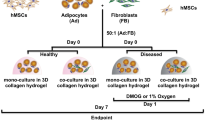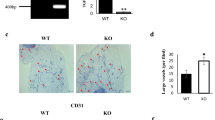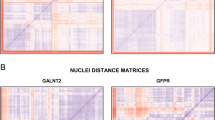Abstract
OBJECTIVE: Adipocyte hypertrophy combined with hyperplasia, observed during the growth of adipose tissue in obesity, might promote the occurrence of hypoxic areas within the tissue. The aim of the present study is to assess the influence of hypoxia on the expression and secretion of adipocyte-derived proangiogenic factors.
DESIGN AND METHODS: Differentiated 3T3-F442A adipocytes were submitted either to ambient hypoxia (5% O2) or to chemically induced hypoxia by treatments with cobalt chloride or desferrioxamine. The activities of the matrix metalloproteinases 2 and 9 (MMP-2 and -9) were determined by gelatin zymography. The expression of vascular endothelial growth factor (VEGF), hypoxia inducible factor 1 α (HIF-1α), leptin, MMP-2 and -9 were studied by the use of Western blotting and RT-PCR analyses.
RESULTS: Low oxygen pressure exposure and hypoxia mimics treatments were associated with increased glucose consumption and release of lactate in differentiated 3T3-F442A adipocytes. They also led to an upregulation of the expression of leptin, VEGF and MMPs. An enhanced accumulation of HIF-1α protein was observed in the hypoxic adipocyte nuclei.
CONCLUSION: Hypoxia, in adipocytes, markedly enhances the expression of leptin, VEGF and MMPs and stimulates the HIF-1 pathway. The present data demonstrate that hypoxic adipocytes express more proangiogenic factors and suggest that hypoxia, if occuring in adipose tissue, might be a modulator of the angiogenic process.
This is a preview of subscription content, access via your institution
Access options
Subscribe to this journal
Receive 12 print issues and online access
$259.00 per year
only $21.58 per issue
Buy this article
- Purchase on Springer Link
- Instant access to full article PDF
Prices may be subject to local taxes which are calculated during checkout






Similar content being viewed by others
References
Carmeliet P, Jain RK . Angiogenesis in cancer and other diseases. Nature 2000; 407: 249–257.
Rupnick MA, Panigrahy D, Zhang CY, Dallabrida SM, Lowell BB, Langer R, Folkman MJ . Adipose tissue mass can be regulated through the vasculature. Proc Natl Acad Sci USA 2002; 29: 29.
Bouloumie A, Drexler HC, Lafontan M, Busse R . Leptin, the product of Ob gene, promotes angiogenesis. Circ Res 1998; 83: 1059–1066.
Sierra-Honigmann MR, Nath AK, Murakami C, Garcia-Cardena G, Papapetropoulos A, Sessa WC, Madge LA, Schechner JS, Schwabb MB, Polverini PJ, Flores-Riveros JR . Biological action of leptin as an angiogenic factor. Science 1998; 281: 1683–1686.
Bouloumie A, Sengenes C, Portolan G, Galitzky J, Lafontan M . Adipocyte produces matrix metalloproteinases 2 and 9: involvement in adipose differentiation. Diabetes 2001; 50: 2080–2086.
Chang C, Werb Z . The many faces of metalloproteases: cell growth, invasion, angiogenesis and metastasis. Trends Cell Biol 2001; 11: S37–S43.
Claffey KP, Wilkison WO, Spiegelman BM . Vascular endothelial growth factor. Regulation by cell differentiation and activated second messenger pathways. J Biol Chem 1992; 267: 16317–16322.
Brahimi-Horn C, Berra E, Pouyssegur J . Hypoxia: the tumor's gateway to progression along the angiogenic pathway. Trends Cell Biol 2001; 11: S32–S36.
Wang GL, Jiang BH, Rue EA, Semenza GL . Hypoxia-inducible factor 1 is a basic-helix–loop–helix-PAS heterodimer regulated by cellular O2 tension. Proc Natl Acad Sci USA 1995; 92: 5510–5514.
Hirsch J, Batchelor B . Adipose tissue cellularity in human obesity. Clin Endocrinol Metab 1976; 5: 299–311.
Wang GL, Semenza GL . General involvement of hypoxia-inducible factor 1 in transcriptional response to hypoxia. Proc Natl Acad Sci USA 1993; 90: 4304–4308.
Wang GL, Semenza GL . Desferrioxamine induces erythropoietin gene expression and hypoxia-inducible factor 1 DNA-binding activity: implications for models of hypoxia signal transduction. Blood 1993; 82: 3610–3615.
Chomczynski P, Sacchi N . Single-step method of RNA isolation by acid guanidinium thiocyanate–phenol–chloroform extraction. Anal Biochem 1987; 162: 156–159.
Poltorak Z, Cohen T, Sivan R, Kandelis Y, Spira G, Vlodavsky I, Keshet E, Neufeld G . VEGF145, a secreted vascular endothelial growth factor isoform that binds to extracellular matrix. J Biol Chem 1997; 272: 7151–7158.
Wenger RH . Cellular adaptation to hypoxia: O2-sensing protein hydroxylases, hypoxia-inducible transcription factors, and O2-regulated gene expression. FASEB J 2002; 16: 1151–1162.
Cooper JD, Pearson FG, Patterson GA, Todd TR, Ginsberg RJ, Goldberg M, DeMajo WA . Technique of successful lung transplantation in humans. J Thorac Cardiovasc Surg 1987; 93: 173–181.
Murdoch C, Finn A . Chemokine receptors and their role in vascular biology. J Vasc Res 2000; 37: 1–7.
Green H, Kehinde O . Spontaneous heritable changes leading to increased adipose conversion in 3T3 cells. Cell 1976; 7: 105–113.
Firth JD, Ebert BL, Pugh CW, Ratcliffe PJ . Oxygen-regulated control elements in the phosphoglycerate kinase 1 and lactate dehydrogenase A genes: similarities with the erythropoietin 3′ enhancer. Proc Natl Acad Sci USA 1994; 91: 6496–6500.
Loike JD, Cao L, Brett J, Ogawa S, Silverstein SC, Stern D . Hypoxia induces glucose transporter expression in endothelial cells. Am J Physiol 1992; 263: C326–C333.
Jansson PA, Smith U, Lonnroth P . Evidence for lactate production by human adipose tissue in vivo. Diabetologia 1990; 33: 253–256.
de Glisezinski I, Crampes F, Harant I, Havlik P, Gardette B, Jammes Y, Souberbielle JC, Richalet JP, Riviere D . Decrease of subcutaneous adipose tissue lipolysis after exposure to hypoxia during a simulated ascent of Mt Everest. Pflugers Arch 1999; 439: 134–140.
Zhang QX, Magovern CJ, Mack CA, Budenbender KT, Ko W, Rosengart TK . Vascular endothelial growth factor is the major angiogenic factor in omentum: mechanism of the omentum-mediated angiogenesis. J Surg Res 1997; 67: 147–154.
Ailhaud G, Grimaldi P, Negrel R . Cellular and molecular aspects of adipose tissue development. Annu Rev Nutr 1992; 12: 207–233.
Grosfeld A, Zilberfarb V, Turban S, Andre J, Guerre-Millo M, Issad T . Effects of hypoxia on human PAZ6 adipocytes. Diabetologia 2002; 45: 527–530.
Ben-Yosef Y, Lahat N, Shapiro S, Bitterman H, Miller A . Regulation of endothelial matrix metalloproteinase-2 by hypoxia/reoxygenation. Circ Res 2002; 90: 784–791.
Canning MT, Postovit LM, Clarke SH, Graham CH . Oxygen-mediated regulation of gelatinase and tissue inhibitor of metalloproteinases-1 expression by invasive cells. Exp Cell Res 2001; 267: 88–94.
Ivan M, Kondo K, Yang H, Kim W, Valiando J, Ohh M, Salic A, Asara JM, Lane WS, Kaelin Jr WG . HIF alpha targeted for VHL-mediated destruction by proline hydroxylation: implications for O2 sensing. Science 2001; 292: 464–468.
Jaakkola P, Mole DR, Tian YM, Wilson MI, Gielbert J, Gaskell SJ, Kriegsheim A, Hebestreit HF, Mukherji M, Schofield CJ, Maxwell PH, Pugh CW, Ratcliffe PJ . Targeting of HIF-alpha to the von Hippel–Lindau ubiquitylation complex by O2-regulated prolyl hydroxylation. Science 2001; 292: 468–472.
Ogata Y, Enghild JJ, Nagase H . Matrix metalloproteinase 3 (stromelysin) activates the precursor for the human matrix metalloproteinase 9. J Biol Chem 1992; 267: 3581–3584.
Stetler-Stevenson WG . Matrix metalloproteinases in angiogenesis: a moving target for therapeutic intervention. J Clin Invest 1999; 103: 1237–1241.
Semenza GL . Oxygen-regulated transcription factors and their role in pulmonary disease. Respir Res 2000; 1: 159–162.
Semenza GL, Jiang BH, Leung SW, Passantino R, Concordet JP, Maire P, Giallongo A . Hypoxia response elements in the aldolase A, enolase 1, and lactate dehydrogenase A gene promoters contain essential binding sites for hypoxia-inducible factor 1. J Biol Chem 1996; 271: 32529–32537.
Ambrosini G, Nath AK, Sierra-Honigmann MR, Flores-Riveros J . Transcriptional activation of the human leptin gene in response to hypoxia: involvement of hypoxia-inducible factor 1. J Biol Chem 2002; 25: 25.
Grosfeld A, Turban S, André J, Cauzac M, Challier J-C, Hauguel-de Mouzon S, Guerre-Millo M . Transcriptional effect of hypoxia on placental leptin. FEBS 2001; 502: 122–126.
Minchenko A, Salceda S, Bauer T, Caro J . Hypoxia regulatory elements of the human vascular endothelial growth factor gene. Cell Mol Biol Res 1994; 40: 35–39.
Dachs GU, Tozer GM . Hypoxia modulated gene expression: angiogenesis, metastasis and therapeutic exploitation. Eur J Cancer 2000; 36: 1649–1660.
Considine RV, Sinha MK, Heiman ML, Kriauciunas A, Stephens TW, Nyce MR, Ohannesian JP, Marco CC, McKee LJ, Bauer TL . Serum immunoreactive-leptin concentrations in normal-weight and obese humans. N Engl J Med 1996; 334: 292–295.
Acknowledgements
We thank Christine Arragon for excellent technical assistance and Dr Cecilia Holm (Department of Cell and Molecular Biology, Lund University, Sweden) for providing us polyclonal chicken antibody against the hormone-sensitive lipase (HSL).
Author information
Authors and Affiliations
Corresponding author
Rights and permissions
About this article
Cite this article
Lolmède, K., Durand de Saint Front, V., Galitzky, J. et al. Effects of hypoxia on the expression of proangiogenic factors in differentiated 3T3-F442A adipocytes. Int J Obes 27, 1187–1195 (2003). https://doi.org/10.1038/sj.ijo.0802407
Received:
Revised:
Accepted:
Published:
Issue Date:
DOI: https://doi.org/10.1038/sj.ijo.0802407
Keywords
This article is cited by
-
Intra-abdominal adipose depot variation in adipogenesis, lipogenesis, angiogenesis, and fibrosis gene expression and relationships with insulin resistance and inflammation in premenopausal women with severe obesity
Journal of Physiology and Biochemistry (2022)
-
Hypoxia and exercise interactions on skeletal muscle insulin sensitivity in obese subjects with metabolic syndrome: results of a randomized controlled trial
International Journal of Obesity (2020)
-
Obesity and gastrointestinal cancer: the interrelationship of adipose and tumour microenvironments
Nature Reviews Gastroenterology & Hepatology (2018)
-
Hypoxia-regulated mechanisms in the pathogenesis of obesity and non-alcoholic fatty liver disease
Cellular and Molecular Life Sciences (2016)
-
Molecular regulation of the expression of leptin by hypoxia in human coronary artery smooth muscle cells
Journal of Biomedical Science (2015)



